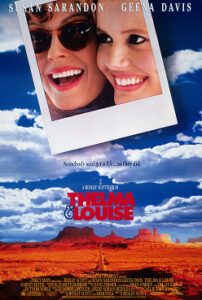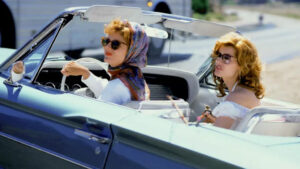“Thelma & Louise” – “Desperate Housewives”

Title: “Thelma & Louise”
Release Date: 1991
Director: Rildey Scott
Cast: Susan Sarandon, Geena Davis, Harvey Keitel, Michael Madsen, Brad Pitt
Ridley Scott’s “Thelma & Louise” offers viewers a wild, crazy journey through the vast wilderness to the very heart of America. However, an exciting vacation quickly turns for the heroines into an escape from male aggression, the justice system and the role assigned to them by the patriarchy. So the women are faced with a choice: surrender or fight for themselves. They choose freedom with full knowledge of the tragic consequences, and the holiday adventure turns into a road of no return… Bravura performances were created here by Susan Sarandon and Geena Davis.
“Thelma & Louise” – a story of rebellious women
This story begins classically: here are two friends who secretly go on a crazy vacation together for a few days. Thelma (Geena Davis), a housewife stifled by her husband on a daily basis, does not inform her apodictic spouse of her plan and simply leaves him dinner in the oven along with a short message. Louise (Susan Sarandon), a feisty, hardy waitress also conceals the trip from her partner, packs up her belongings and drives her convertible briskly up to her friend’s house. It quickly becomes apparent that the usually poised and shy Thelma, away from home, becomes a cheerful, open-minded girl eager for carefree fun. In turn, bold Louise tries to tone down her friend’s behavior.
On the way to the cabin in the mountains, the women stop at a roadside bar, where they drink fancy drinks, and Thelma allows herself to be invited to dance by a man who is clearly interested in her. When Louise goes to the restroom, her friend goes outside with the man to get some air. The man quickly becomes aggressive and tries to rape Thelma. However, she is rescued from her predicament by her friend: led off balance by the insulting type, Louise shoots him with a pistol that her friend had taken on the trip just in case. From here begins an adventurous escape of the heroines from the pursuing police towards the Mexican border….

The movie “Thelma & Louise” – a unique work of Ridley Scott
“Thelma & Louise” is a unique item in Ridley Scott’s cinema not only because it presents an eminently female perspective, but also because of the Europeanness of the director’s outlook that is noticeable here. Namely, the film of the British man grows out of the adoption of a distanced, external position of the author towards the American culture, which situates this picture among such works of Scott’s as “Someone to Watch Over Me” (1987) and “Black Rain” (1989). It’s the optics of a European who sees the incredibly oppressive social code of the US for women. Someone raised on the Old Continent, the confrontation with the American model of patriarchy must have prompted reflection, and critical reflection at that.
A sign of this perspective is the director’s chosen genre: road cinema. Here we have a journey of female characters across the United States to one of the most iconic places in America: the Grand Canyon. This trip becomes the same as learning about the laws governing the whole society, and, above all, showing them from the point of view of women. At the same time, the escape to the wilderness of the canyon becomes a sign of liberation of female characters from the cultural ties and laws that bind them.
It turns out that the latter are based on male domination, represented here by the typical pattern of the American hero. The men present in “Thelma & Louise” are cowboys, gun-toting lawmen and replica husbands trying to respect the patriarchal order in their homes. Each of these characters harms the heroines in different ways: using psychological violence, raping, exploiting or cheating.

They are all links of social control over women seen primarily as sex objects. The only heroes who break out of this pattern are Louise’s partner Jimmy (Michael Madsen) who delivers her promised money and Detective Hal Slocumb (Harvey Keitel) who tries to prevent the death of the escaped women. Their voice of dissent, however, is too weak and disappears in the thick of the violence. This is brilliantly conveyed in the final, finely detailed frames, when the camera from above shows the car of the heroines, behind which a whole “pack” of police cars marches like a pack of wolves honoring their prey. Plastic perfection, which is a manifestation of thinking with images, is, moreover, a typical feature of the cinema of Ridley Scott, who in each of his films uses his graphic training and many years of experience making music videos.
“Thelma & Louise” – women under pressure
“Thelma & Louise” is a movie that is difficult not to consider in the context of the theory of feminism, because at every level it tells the world precisely from the perspective of women. Magnificent performances by Susan Sarandon and Geena Davis bring out all possible qualities in their female characters. Contrastingly conceived characters expose different facets of femininity: the fragile, fearful and compliant one, but also the feisty, playful and strong one. Moreover, the personalities of the two heroines seem interchangeable. Sometimes Louise takes the lead, while at other times Thelma takes the lead. Their peculiar identities are underscored by a scene in which Thelma imitates her friend by making various faces at a mirror with a cigarette in her mouth and says: “I’m Louise.” The latter, on the other hand, sits quietly in her car and improves her makeup in the mirror while her companion commits the robbery.
Perhaps the two heroines constitute one character – simply a woman and the various scenarios of her life: as a housewife or an independent, feisty suffragette, weak and strong, dreamy and hard-headed. It is also significant that the unquestionable evolution of the characters, which makes them individuals alienated from the prevailing social order (a constant feature of Ridley Scott’s cinema), ultimately aims to bridge the differences between Thelma and Louise as much as possible. This is communicated by Thelma’s famous phrase: “Something in me has broken… and I can’t go back,” which announces her decision to stay by her friend’s side until the end. This peculiar unity of the heroines is emphasized not only by their jointly chosen direction and their behavior, but also by their physical transformation. Initially, the image of both characters is very feminine, although completely in different models.

Therefore, at the beginning of the trip, we see the embraced, neatly combed and buttoned-up Louise in an elegant blouse and the eternal dreamer Thelma in a ruffled top and airy skirt. By the end of the trip, both women have tousled hair, wear jeans and T-shirts, almost symbolically taking on male attributes. Their transformation is brilliantly conveyed in the scene when they lure the bawdy truck driver aside to teach him a lesson. Again, an unforgettable, elaborate frame: the heroines sit in masculine poses in a convertible, holding revolvers ready to fire behind the waistband of their pants.
The ending of “Thelma & Louise,” as in most of Scott’s movies, remains open-ended. We see the car of the heroines over the precipice of the canyon – will they die, or will they succeed again? A seemingly tragic situation is portrayed in bright, optimistic colors. The car seems to rise to the sky, it is the apotheosis of freedom, for Thelma and Louise more precious than anything else, more precious than life.
Literature:
M. Smoleń, „Ridley Scott – gladiator na arenie Hollywood”, [w:] „Mistrzowie kina amerykańskiego. Współczesność”, pod red. Ł. A. Plesnara i R. Syski, Kraków 2010.
